It is almost 30 years since Denmark last lifted the European Championship trophy, winning the competition in 1992. In truth, they’ve struggled to get close to those levels since that triumph, but their squad going into this European Championship is arguably more talented than it has been in recent years – the likes of Christian Eriksen, Pierre-Emile Højbjerg and Kasper Schmeichel are all incredibly gifted players, and Denmark have the luxury of having a good youth production too, a good number of young, home grown players are in with a shout of making a difference this summer.
Denmark failed to qualify for the last instalment of this competition in 2016, so we have to reach back to Euro 2012 to look at their last outing. In that competition, they failed to get out of the group stage. In fact, Denmark haven’t reached the knockout rounds of the European Championship since 2004, where they bowed out at the quarter-finals. While there are an abundance of strong and exciting teams entering this year’s competition, Denmark will play to their strengths and look to give anybody a test – Belgium, Russia, and Finland join them in group B, so they will definitely fancy their chances at making it to the knockout rounds.
THE SQUAD
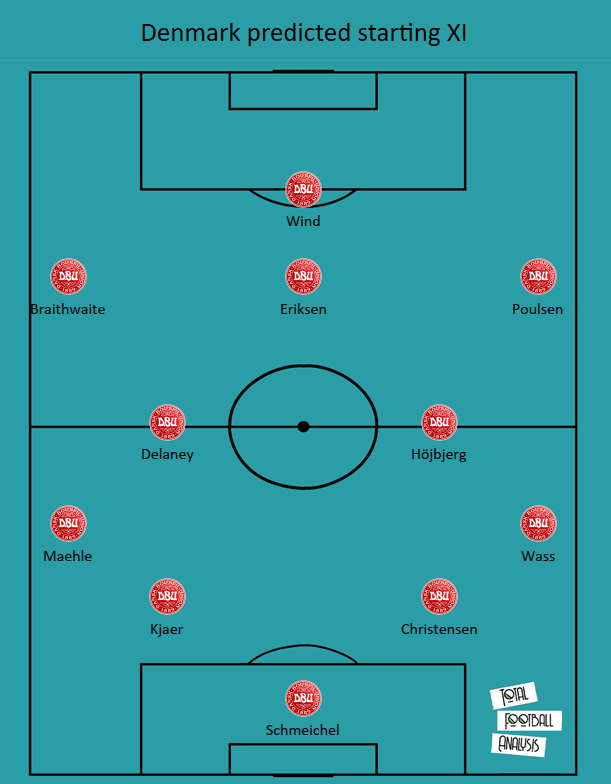
Above is what we believe to be Denmark’s strongest line-up for the summer, with their central midfield unit holding the key to any success they are to have, in terms of quality. Their pace on the wings and decent experience in defence will also come into play.
They have an absolute stalwart between the sticks in Kasper Schmeichel, having years of international and Premier League experience to his name. In front of him, he has the experienced Simon Kjaer and Andreas Christensen who, despite only making 17 appearances for the London club in 2020/21, still has good experience at both Premier League and Champions League level. The versatility of Daniel Wass will be something of a secret weapon for the Danish – the Valencia man is more than capable of playing several positions, from either full-back, to a defensive midfield role, to a number 10 role.
As we touched upon, that central 3 for Denmark is an important area in terms of the quality at their disposal: in the advanced role is Christian Eriksen who, despite having some issues at Inter and struggling for starting places in that side, possesses great natural quality as we saw during his time at Tottenham Hotspur. His vision and creativity can turn regular phases of play into dangerous attacking sequences with ease. The defensive cover behind him in midfield comes from Borussia Dortmund’s Thomas Delaney and Tottenham’s Pierre-Emile Højbjerg. Delaney has been a mainstay in Dortmund’s side for a number of years now, providing stability in their midfield ranks, while Højbjerg has enjoyed an impressive season at Spurs in both defensive and attacking elements. The pace on the wings is essential for this side to break through into the final third to allow them to ultimately create dangerous chances. Barcelona’s Martin Braithwaite is expected to operate on the left (despite naturally being a striker, he is an accomplished winger.) While he isn’t blessed with blistering pace, his agility on the ball might just be enough to beat a defender and break into the box. Meanwhile, on the right flank, Yussuf Poulsen, also a natural striker capable of playing in wide areas, is expected to make the cut. He does possess pace, and the ability to drive at defenders with the ball at his feet – combining with Wass and Eriksen could be Denmark’s attacking key.
Below, we have the confirmed 26-man squad that Denmark will be taking to Euro 2020:
Goalkeepers:
Jonas Lossl
Frederik Ronnow
Kasper Schmeichel
Defenders:
Joachim Andersen
Nicolai Boilesen
Andreas Christensen
Mathias Jorgensen
Simon Kjaer
Joakim Maehle
Jens Stryger Larsen
Jannik Vestergaard
Daniel Wass
Midfielders:
Anders Christiansen
Christian Eriksen
Thomas Delaney
Pierre-Emile Hojbjerg
Mathias Jensen
Christian Norgaard
Forwards:
Martin Braithwaite
Andreas Cornelius
Mikkel Damsgaard
Kasper Dolberg
Yussuf Poulsen
Robert Skov
Andreas Skov Olsen
Jonas Wind
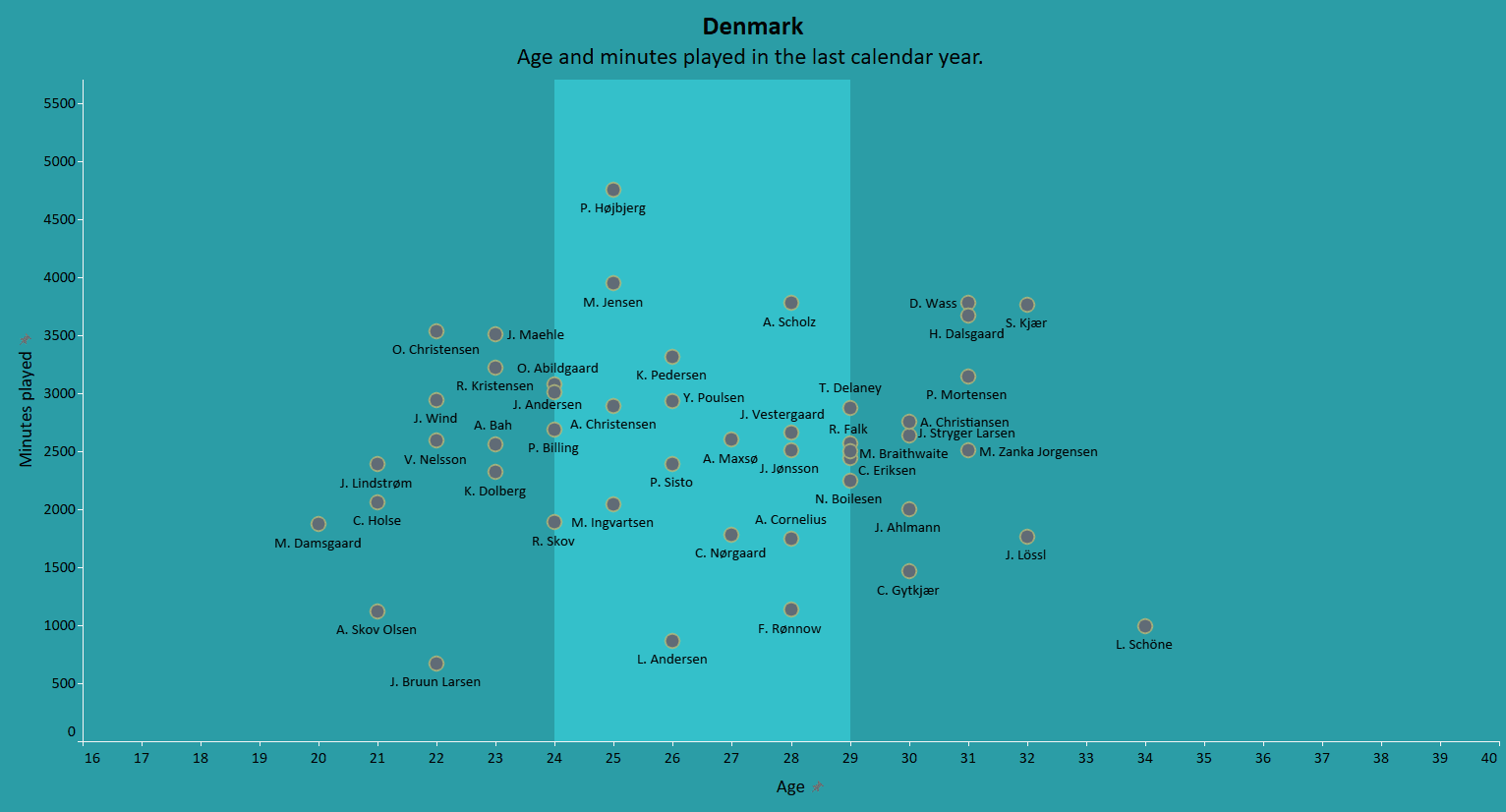
As we can see in the graph above, the ages within the expected Denmark squad are fairly balanced – a good mixture of youth and experience: vital for a team at the level of Denmark. Kasper Schmeichel stands out in terms of minutes played this season for his club, playing a pivotal role in Leicester City’s impressive season, meaning he will go into the Euros in tip-top form. Højbjerg has also accumulated a good number of minutes at Spurs, and he will also be hoping to carry his form into the national side. There are plenty of experienced players in the team with a good level of quality – Wass, Kjaer, and Dalsgaard for example, will be important cogs in this team, particularly in pressure games. Looking at the other end of things, they have a strong number of younger players who have gained valuable experience at their respective clubs this season – players such as Maehle, Oliver Christensen, Oliver Abildgaard, and Jonas Wind to name a few will be able to inject that bit of youth into the side. We can see through our data that Christian Eriksen has not amassed the amount of playing time that he would’ve wanted, but his involvement in the Danish set-up is still crucial.
ATTACKING PHASE
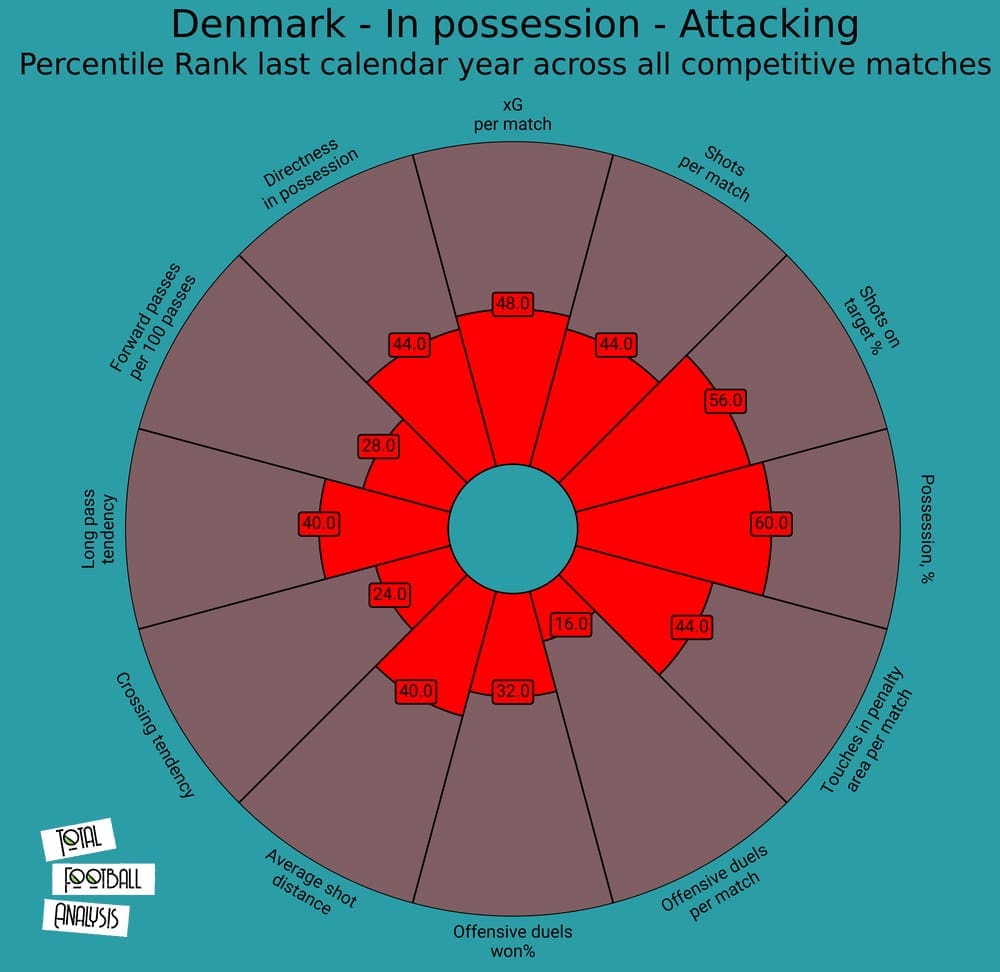
We are unlikely to see Denmark try and control a game the way Spain in 2012 would, for example, and that is reflective in the graph above. While they will look to attack where possible as they know dominating possession will be a difficult task for them, they have the players capable of doing just that in the right moments. As we can see above, their attacking approach does have an element of flexibility to it: their percentile ranking of 44 for directness in possession suggests that they are capable of launching attacks with a variety of pass lengths – this will depend on their opponent; in games which they are the favourites, they may look to put shorter passing combinations together, for example. Their ranking for xG also suggests that they have an eye for goal, and when you look at their results over the last year or so, this is backed up further – their squad depth and versatility also help with this, making them somewhat unpredictable in parts. However, don’t expect them to make a high number of crosses as this doesn’t play into their arsenal – they don’t impress a great deal in various areas for duels either. Below are a couple of examples of potential attacking tactics that Denmark could deploy this summer.
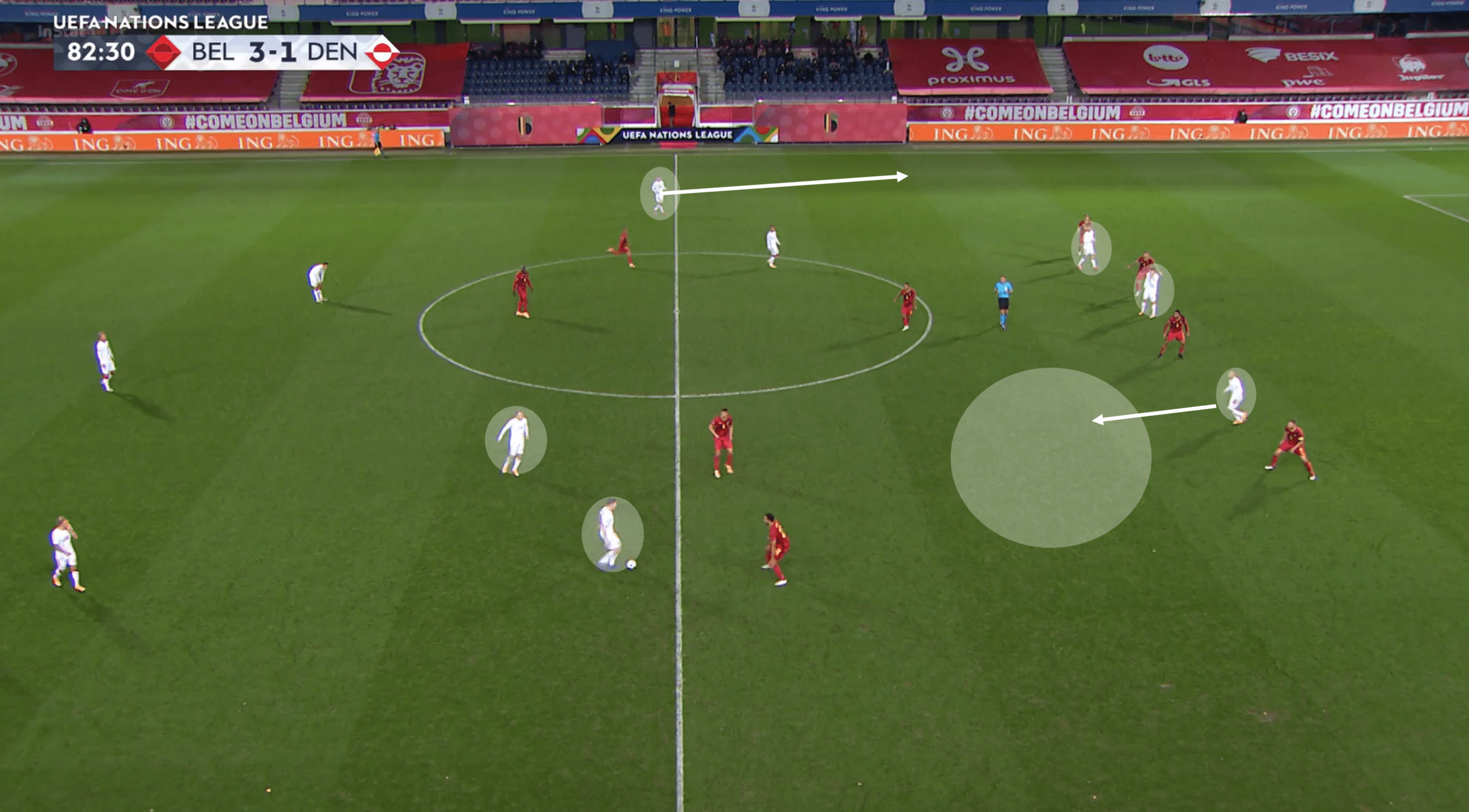
In those portions of a game where Denmark will in fact look to take control of the game in search of a needed goal, they will look to push the full-backs into attacking positions. In the example above, Belgium’s back four remains compact and tight yet not deep. Denmark’s front three mirror this, with their two wingers tucking inside to give that back four an extra job – an extra incentive to remain compact. This allows space on the flanks which can be exploited, mainly through the talents of their talisman, Christian Eriksen – we will touch on his role a little later. Denmark also have an eye for details, and know when to strike when the opposition’s set up is poor. As we can see above, Belgium’s midfield unit shape is a strange one, only encouraging Denmark to build their attack. The right winger of Denmark (Lucas Anderson in this case) notices the large unattended area between the Belgium midfield and defence, and the attacking potential that comes with it. If Denmark are able to take advantage of these types of scenarios, where they create not one, but two promising outlets of attack (far flank and central space), they will be an exciting team to watch.
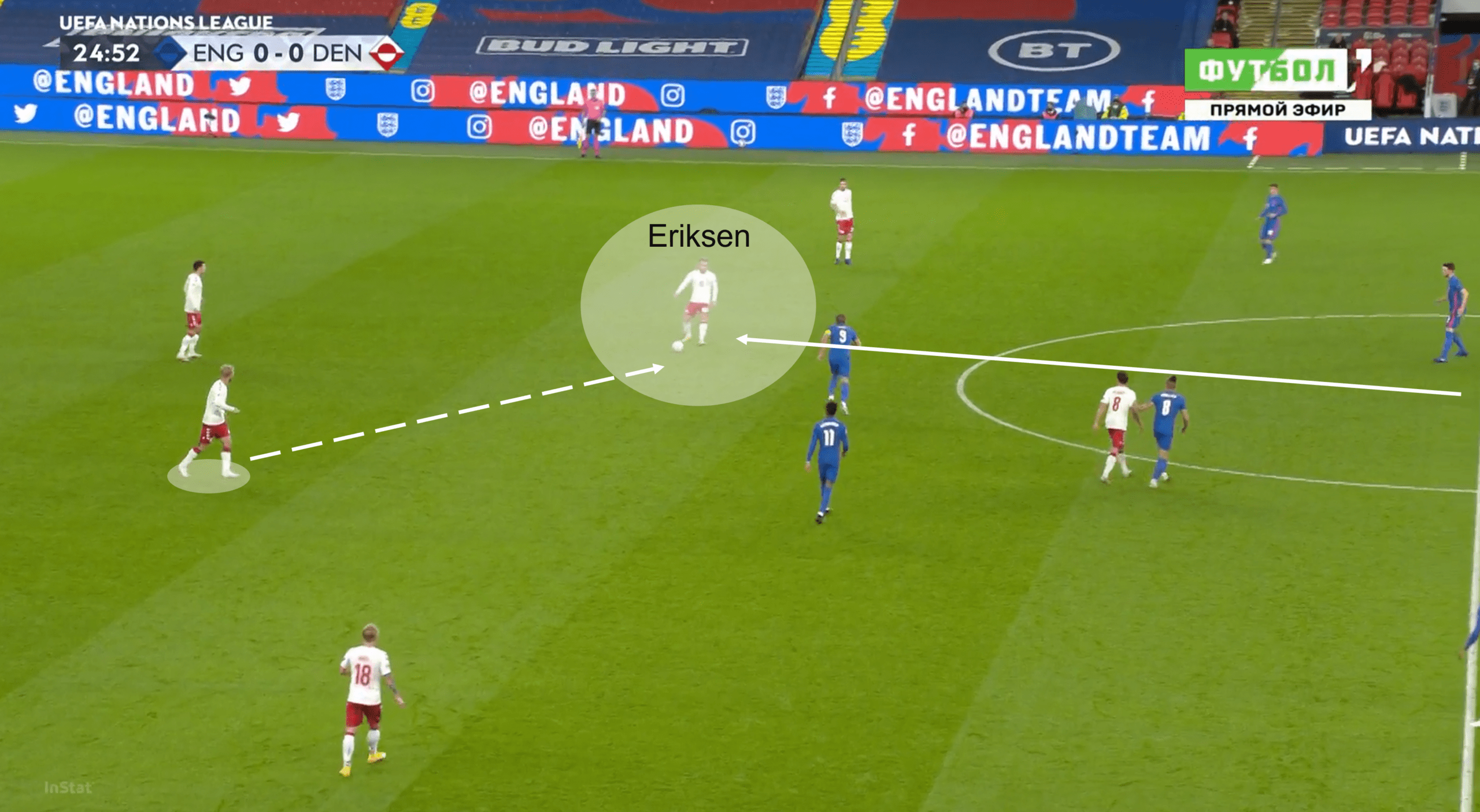
As we mentioned previously, Eriksen’s role is pivotal to Denmark’s attacking tactics and ultimately, their chances of success. We also mentioned that he likes to operate in areas where we aren’t used to seeing him, to fit the needs of his teammates. While he is involved in many of Denmark’s dangerous attacks, both from central areas and on the flanks, in times where Denmark are struggling to progress up the field, Eriksen will drift into a deeper zone to offer himself as a passing option. His creative abilities allow him to turn average possession in areas like the one above into potential attacking phases – whether he’s driving forward via dribbling or by putting his passing range to good use. Furthermore, because he usually drifts in deeper from a more attacking position, he very rarely gets tightly marked in these deeper areas, making him even more dangerous to opponents.
DEFENSIVE PHASE
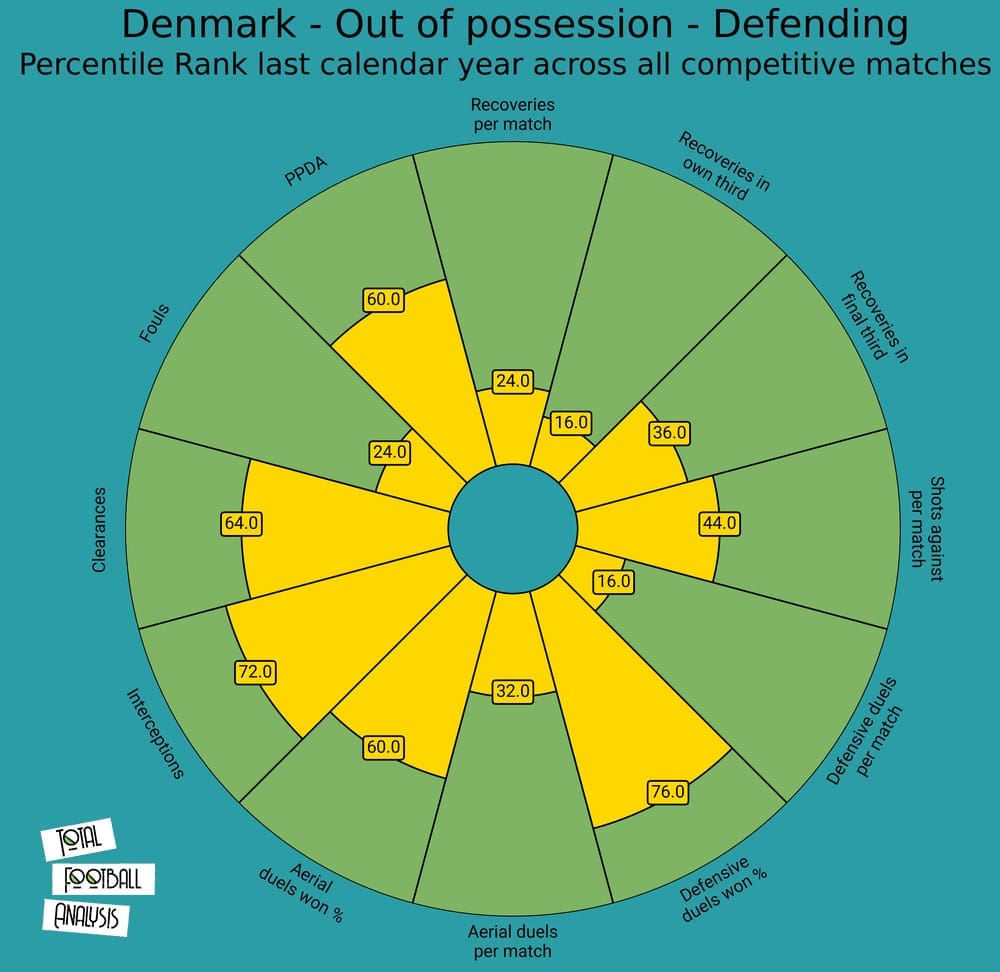
If Denmark are to find success of any level this summer, they will have to be defensively organised and difficult to break down. Above, we can start to get a sense of how they have performed in a defensive manner, particularly in key areas like interceptions and defensive duels won. But as we can also see, their ranking for recoveries, in both their own half and the final third, is quite low, which tells us not to expect a high level of intense pressing. Playing out from the back is another thing we may not see a lot of from Denmark, as we can tell from their interceptions percentile rank – there is a suggestion that when they are under pressure defensively, they are well aware of when to simply clear the ball up field rather than risking short passing combinations to get out of danger. This could also be used to launch counter attacks if the opposition leave themselves short at the back, particularly in the flanks, as we have seen that Denmark are capable of turning transitions into dangerous chances. Below is an example of Denmark are likely to approach the defensive side of things, particularly when they’re up against it, facing a team stronger than themselves.
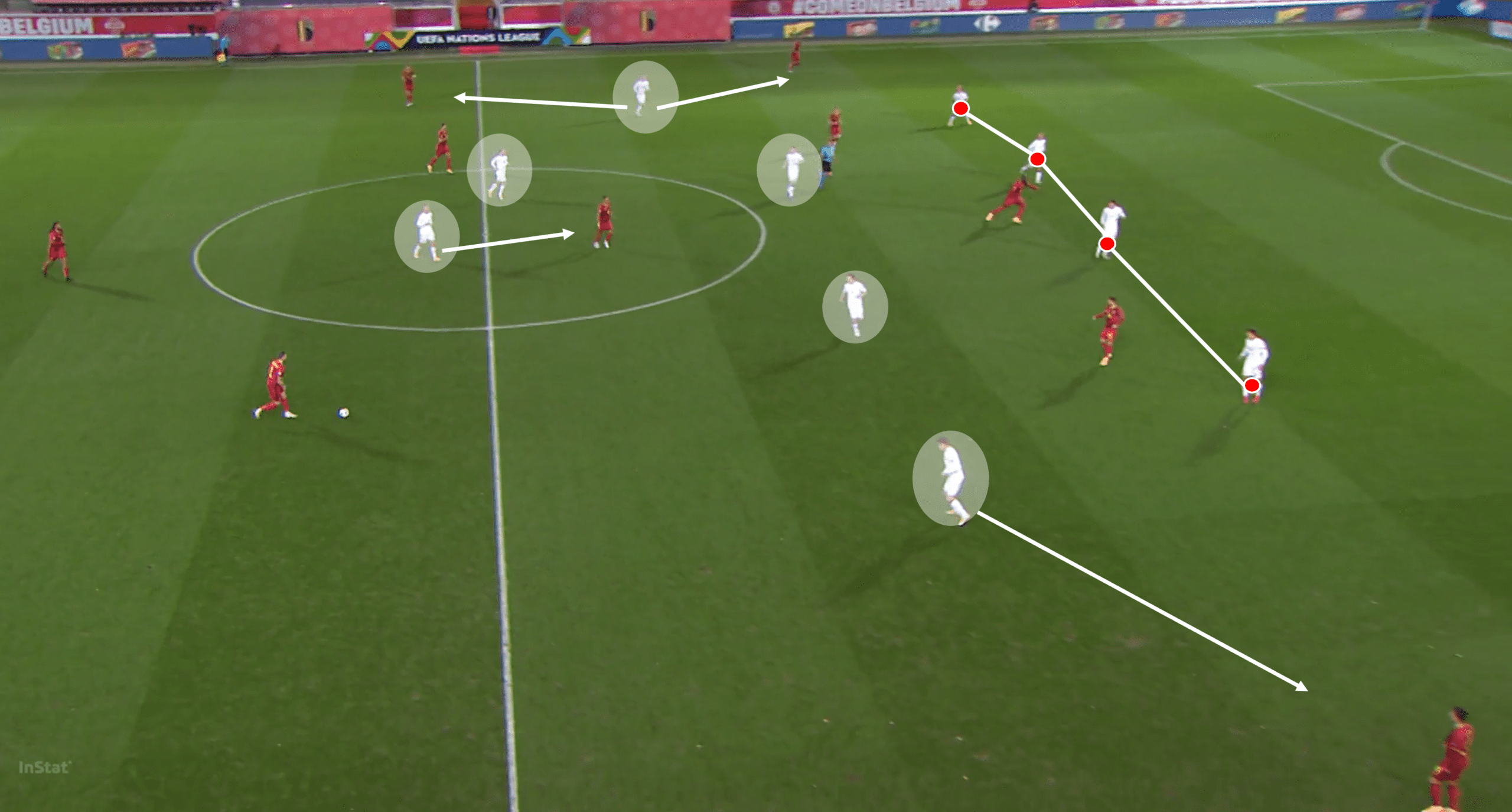
As we can see above, Denmark are well-drilled defensively, with each unit having their own instructions to make life difficult for their opponents. The back four is very compact, allowing the full-backs to lend a helping hand to combat the attacking threat in the middle – their presence in a more narrow zone means that the midfield unit doesn’t have to drop in deeper for this, which allows them to stay a little higher up, blocking off the space for the opposition to play through. The wingers will drop back to make almost a flat four in midfield: their role is to defend the flanks – the opposition wingers. With the full-backs narrow, the job of the two wingers becomes very important, but they also need to keep their own position in mind as they cannot leave too much space between themselves and the central midfielders – having a big gap between the two would allow the opponent to play through the lines a lot easier. Eriksen’s defensive role in this set up is to stay between his striker and midfield unit, just keeping a close eye on any potential passing option. The striker will perform a similar role; unless the ball is played backwards by the opposition, in which case he will look to apply minimal pressure on the opponent’s back line.
TRANSITIONS
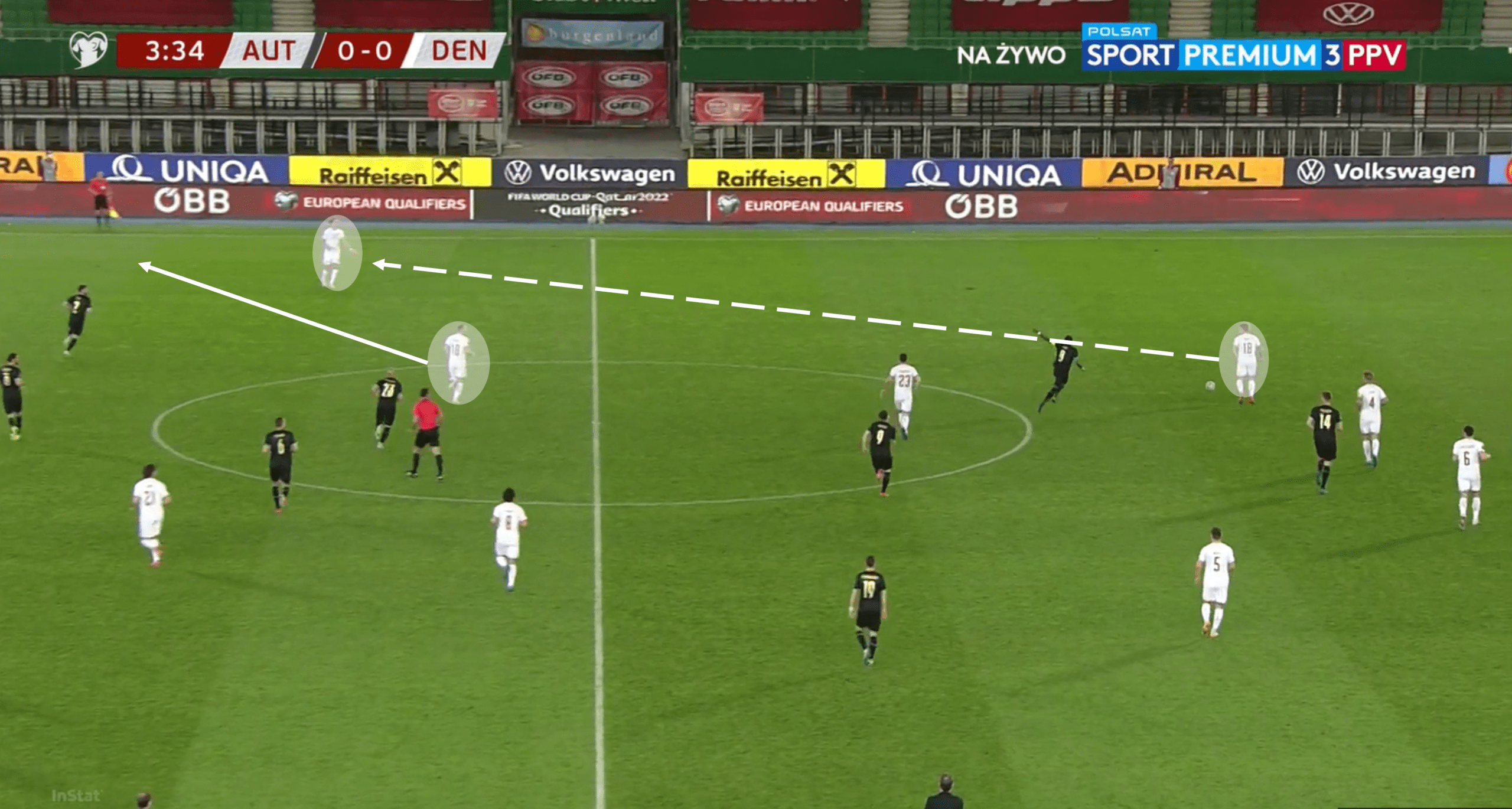
Denmark will rotate through different on-the-ball strategies in terms of attacking transitions. We are unlikely to see them burst into an intense counter attack the way Liverpool would, for example, but this isn’t to say that they will look for the chance to move their possession further up field given the chance. As mentioned previously, they will often operate with a narrow defensive unit, with their teammates on the flanks having some good space to work with in the event of a turnover. Timing is key in these little moments. Poulsen, the man on the right-flank about to receive the ball, doesn’t drop deeper instantly to make a better angle for the pass. He instead peels off away from his full-back marker ever so slightly, at the final possible moment. This causes his marker to follow him, leaving space to be exploited. At this point, a teammate (Eriksen in this example) will drift into the space left by the opposition full-back, giving Denmark the chance to create a numerical advantage in a dangerous area out wide. Depending on the match scenario, we won’t always see this type of move from Denmark – we may see Eriksen drop deeper again to help his side maintain possession if they are looking to simply defend a lead.
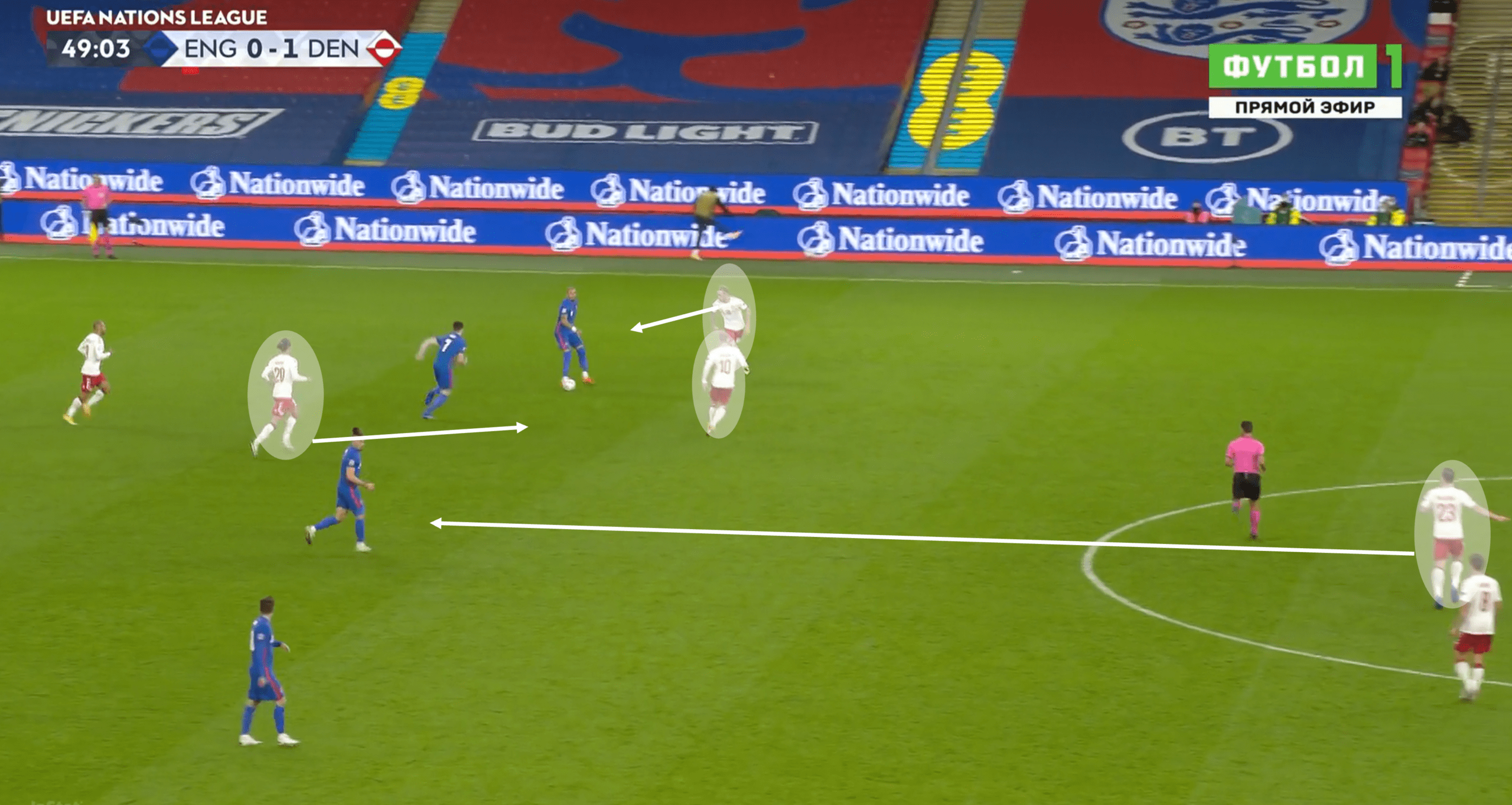
Defensively, as with attacking transitions, Denmark’s approach will fluctuate. In games where they fancy themselves as the favourites or in games where they are simply out-performing their opponents, they will look to pin their enemies into their own-half on occasion – dependent on a few variables. If Denmark already have the numbers close enough to execute the counter press, they will, unless the opposition find themselves in a dangerous position early in the transition. 2 players will press directly, making it next-to-impossible for the opponent to play forward initially. Pressing support will arrive from either a winger or striker, coming in from a different angle, looking to force the opposition in a certain direction. Denmark’s number 23 midfielder is highlighted above, as his role is also vital. Once the (out of shot) midfield unit is set up, he rushes out to mark and apply pressure to the opposition central option, as this space will otherwise be left unmarked due to these players applying the counterpress. If the opponent breaks through both the initial press and the added midfielder block, Denmark will then simply look to regroup at the back as quickly as possible to deal with the threat.
ATTACKERS
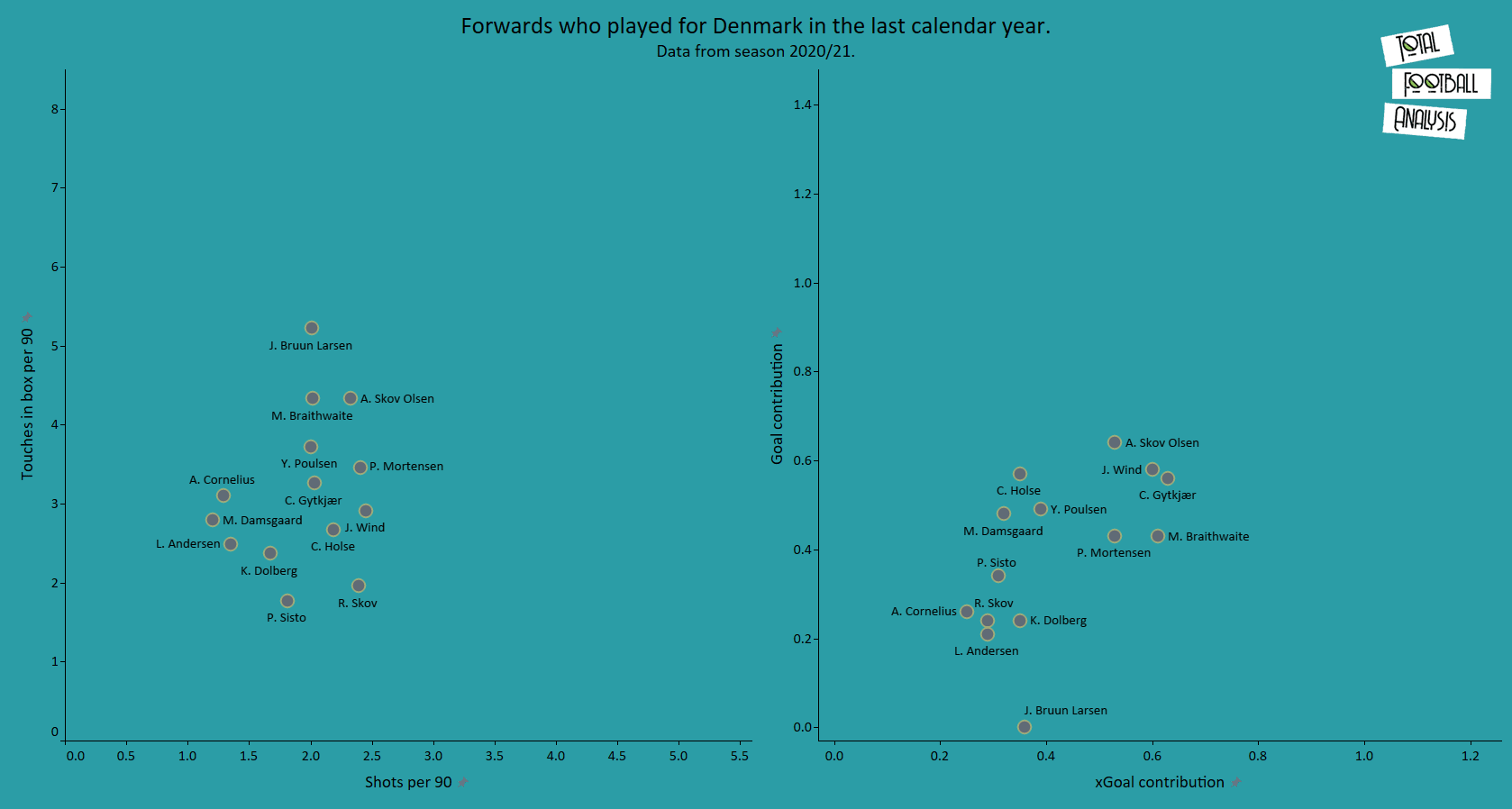
In terms of attacking threat, it’s difficult to identify one player as highly dangerous, but that isn’t to say that Denmark don’t have a capable finisher to get on the end of an attack. Firstly, we will take a look at the player we have tipped to start for Denmark in that centre forward role – Jonas Wind, before analysing the numbers of other potential strikers available for the Danes this summer.
Jonas Wind, currently plying his trade in the top tier of Danish football at Copenhagen, has registered an impressive 11 goals and 4 assists in just 18 games this campaign, and the 22-year-old has given the Denmark management team something of a no-brainer as to who should start up front in the Euros. As we can see from the left-hand graph above, Wind is able to get involved in attacking phases frequently and attempt shots on goal. However, he doesn’t tend to have many touches in the penalty area per 90 minutes, ranking in the bottom half in comparison to other Danish strikers. This shouldn’t be much of an issue when stepping into the Euros this summer, however, as it is likely that a lot of action he sees will require few touches – more shooting on sight.
Looking at the right-hand graph above, we can start to get a sense of Wind’s ability in front of goal. He ranks highly in actual goal contributions, and as we mentioned, he has achieved this in just 18 games – some impressive accomplishment. His record in the xgoal contribution department also suggests that there is potential within him to carry his form into a tournament with tougher opponents this summer.
One thing that is for sure, despite Wind’s obvious goalscoring ability, is that Denmark do have other attacking options in their arsenal – when looking at players who have strong records in goal contributions/xGoal contributions. Despite contributing in just 5 goals total this season for his club side Bologna, 21-year-old Andreas Skov Olsen is an attacking option that can add something different to Denmark’s attacking unit. While he is naturally a winger, capable of operating on either flank, he possesses some qualities that make him a considerable option as a backup/substitute striker. It should be mentioned that Denmark may look to alternative winger options to allow either Poulsen or Braithwaite to operate as the number 9, yet another luxury they have. They also have an experienced option in Christian Gytkjaer. The 31-year-old striker is currently contracted to Serie B side Monza and has registered 6 goals and 5 assists in 2020/21. The 6-foot tall striker has previously earned 9 caps for Denmark, bagging 5 goals in that time.
Two very interesting options that will likely feature as substitutes and/or squad rotation players are Pione Sisto and Robert Skov. While consistency in their respective games is something that lets them down, both players undeniably possess talent – pace, trickery, the ability to get into scoring/assisting positions in attack. If either Braithwaite or Poulsen are required to leave their post as a winger and play as the striker, expect Skov or Sisto to be ready to step in.
MIDFIELDERS
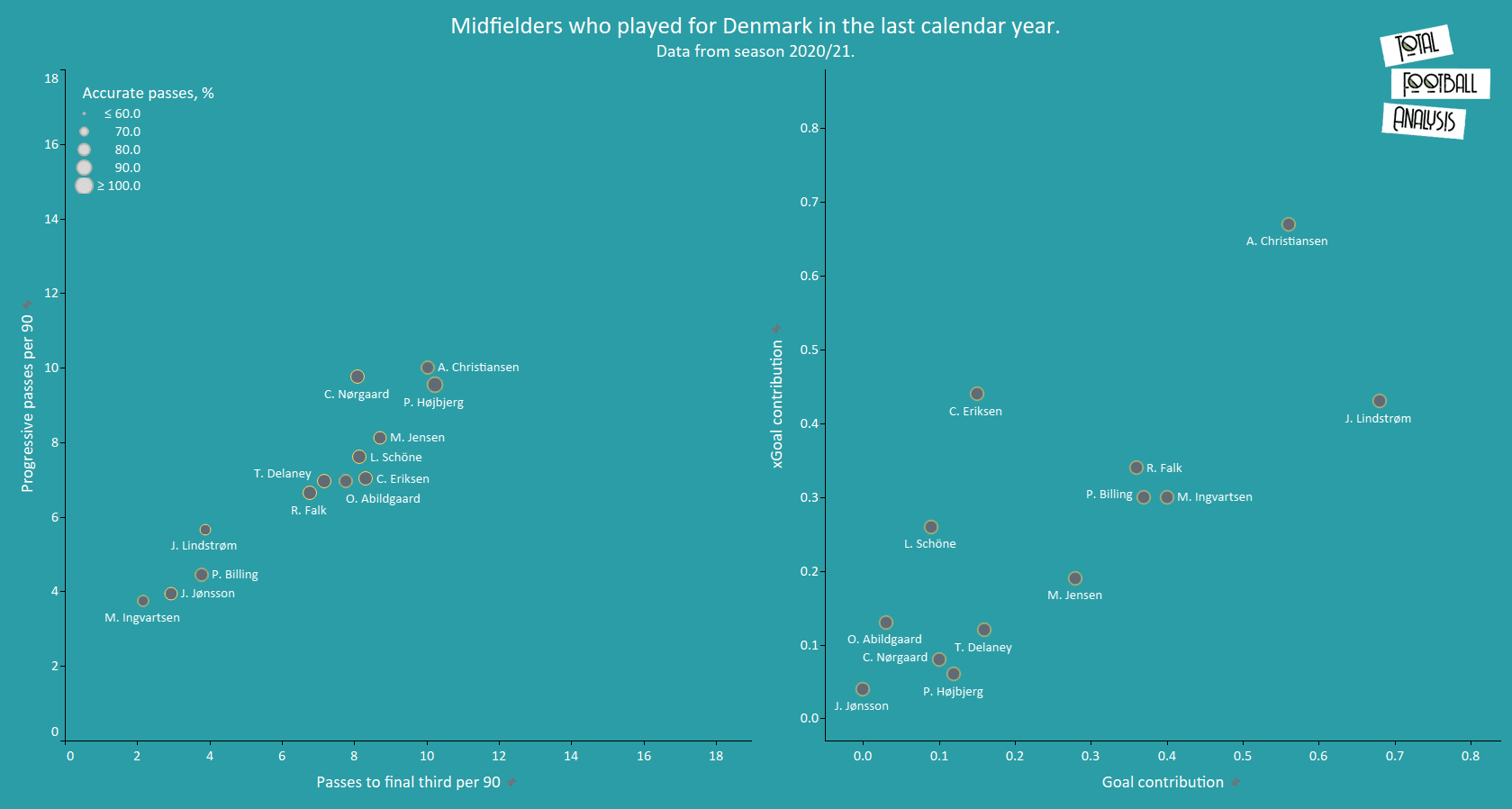
Similar to the case of Denmark’s striker – being that Jonas Wind is almost certain to be their strongest option, Christian Eriksen is guaranteed to start every game that he is fit and ready in that advanced midfield role, with the 2 roles behind him almost certainly going to Delaney and Højbjerg, but squad depth is very important in these kind of tournaments where games thick and fast.
Looking at the left-hand graph above, we can see a number of players have registered good numbers when it comes to passing into the final third and making progressive passes. Christian Nörgaard fits that description, having played a part in Brentford’s impressive season in the EFL Championship, and we will likely see him play a supporting role for his national side when squad rotations are made. 34-year-old Lasse Schöne is also a good option to have amongst the squad. The versatile veteran, currently playing for Heerenveen in the Eredivisie, has an abundance of experience that will play a vital role in Denmark’s journey this summer – it is also likely to be his final international tournament, considering his age. Over recent years, Schöne has demonstrated an impressive skill-set on the ball – a good passing range, good vision, and an eye for goal.
Moving onto the partnering graph, we can start to paint a picture of which midfield players will be of use to Denmark, in consideration to goal contributions. This is an important area for Denmark’s attacking midfielder to be effective due to the team being likely to play with just one striker. As mentioned, Christian Eriksen’s lack of game time at Inter has hampered his actual record of goals and assists this season, but we can see by his record in the xgoal contributions area that this is not a reflection of his talent – the former Spurs man is still highly capable in these areas, hence him being the star man for his team this coming summer. One player who will provide an exciting watch, should he be given the chance, is 21-year-old Jesper Lindström of Bröndby, who has nine goals and nine assists this season. The tricky midfielder holds a good level of potential and could provide an interesting and fresh alternative off the bench if Denmark need to either rest Eriksen or add more attacking midfielders into their system. A more experienced option who could also still be effective is 29-year-old Rasmus Falk of Copenhagen. He has seven goal contributions for his club this campaign and has an element of versatility to his game as he can also operate as a deeper midfielder as well as a winger on either flank. 30-year-old Anders Christian is also an interesting midfield option that Denmark may look to explore. The Malmo midfielder has only made 8 appearances this campaign, but has a very healthy contribution of combined goals/assists, suggesting he has a valuable attacking threat.
DEFENDERS
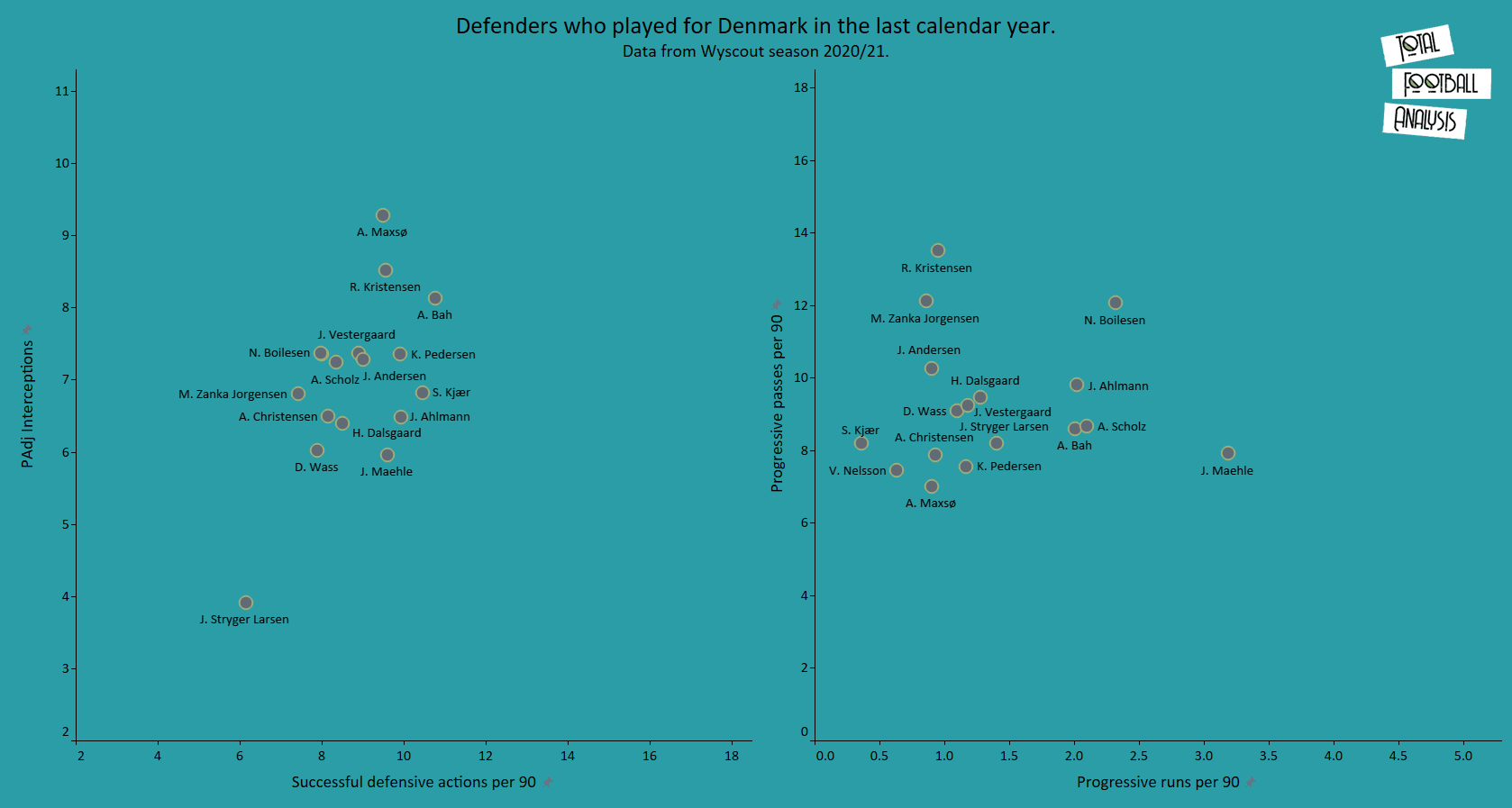
Unless an injury, suspension, or any other unmanageable scenarios crop up for Denmark, we are likely to see few changes to their back four, as maintaining a level of solidarity and consistency will be hugely beneficial in developing chemistry which will assist them in stopping opposition attacks. However, in the even that changes need to be made, the right player must be ready to step in. Here, we will look at some of the stand out players who could make that step up into the starting XI.
Starting with the left-hand graph which looks at defensive contributions, we can see that one candidate who stands out is Andreas Maxsö of Bröndby. The 27-year-old has registered impressive defensive stats that demonstrate his ability to be a solid defender – as we can see from the opposite graph, though, it’s his ability on the ball that may hamper his number of minutes in the Euros. We mentioned earlier that right-back Daniel Wass’s versatility may result in him gaining some minutes in the midfield rather than at the back. In that case, we may see Rasmus Kristensen (RB Salzburg) step in, after the 23-year-old has turned out an impressive season with equally impressive stats in several areas.
As we can see, his defensive capabilities are not to be undermined as he has displayed himself as a solid defender at full-back. Quickly jumping over to the opposite graph, we also get the sense that Kristensen is decent on the ball too, making a good number of progressive passes per 90 minutes; not a lot of progressive runs. The lack of progressive runs, however, could work in his favour as this means he is not bursting out of position, but instead making the passes from right-back.
Switching out focus to the right-hand graph, we can start to understand which Danish defenders are capable with the ball at their feet. As mentioned, Rasmus Kristensen is a prime candidate to step up to the starting 11, as is 29-year-old Nicolai Boilesen, who is currently at Copenhagen. Boilesen’s stats suggest he is more than capable on the ball, making a good number of progressive passes and runs on a match-by-match basis. Furthermore, he is extremely versatile – comfortable in any position along the back four. He also has 18 previous international caps which will only promote his inclusion further. While there are a few players who impress on one of the two areas on the right-side graph, another player who has registered good numbers in both areas is Aab Fodbold’s Jakob Ahlmaan – a 30-year-old left-back who is also capable of playing on the left side of a midfield unit. Our data suggests that he could be an important squad player and that he is comfortable on the ball – he could bring a calming influence in those frantic games.
BEST PERFORMER
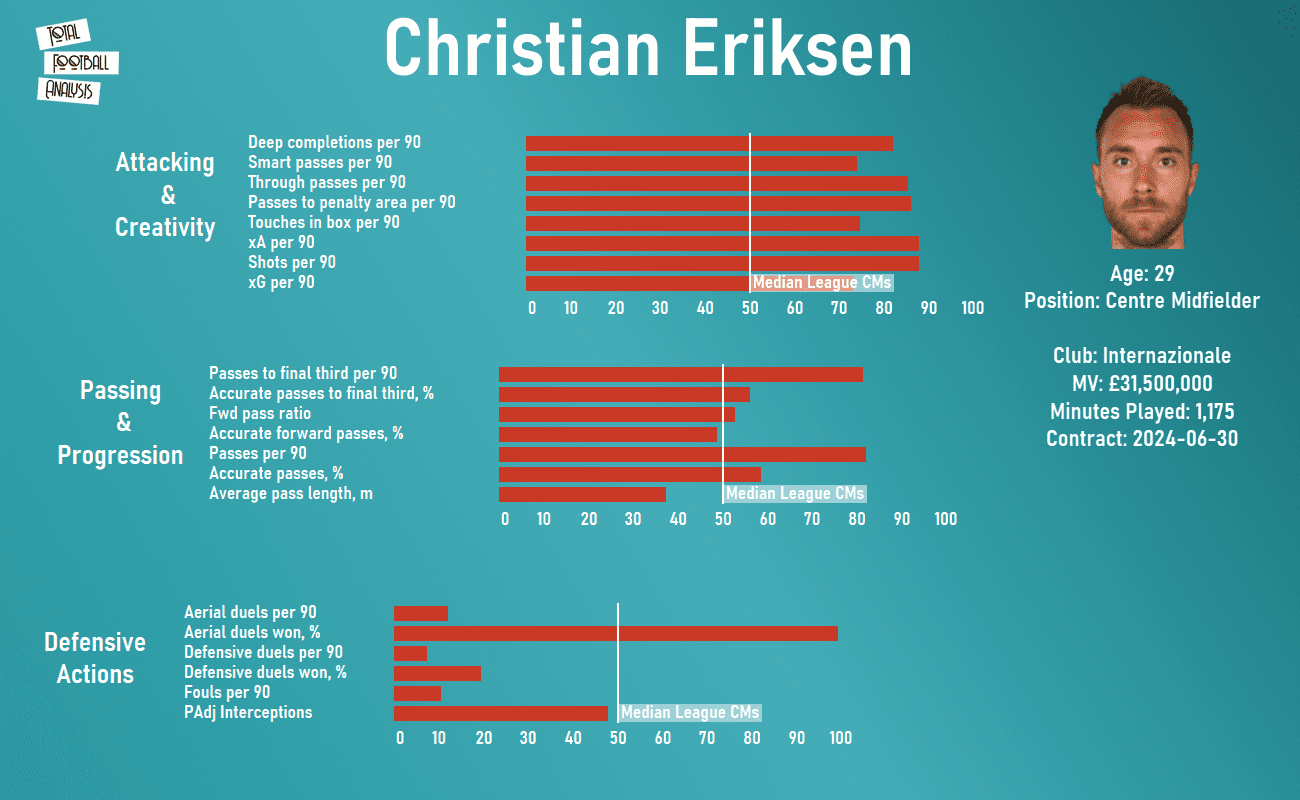
Christian Eriksen’s importance to this Denmark side is undoubtable. While there is an abundance of exciting talent in the squad already, we have seen over the years just what the creative midfielder is truly capable of, and even with his limited appearances this season for Inter, our data shows us that quality.
His averages per 90 minutes in areas such as smart passes, through passes, and passing accuracy all register higher than the median for other central midfielders in Serie A, showing Eriksen’s determination to actually get into helpful positions and perform once he’s on the ball. His average numbers in areas like passes into the penalty area and touches in the penalty area also demonstrate his hunger and ability to contribute effectively in dangerous parts of the pitch, looking to get on the end of attacking moves.
We can also see that he is no stranger to attempting shots on goal, which is something that Denmark will need from midfield as they won’t always have the luxury of creating clear-cut chances for their strikers. Eriksen’s xA and xG are also at an impressive level – another element that Denmark will need to bring out of him to find success this summer.
While his forward passing ratio does go above the average for Serie A central midfielders, this still isn’t that high, suggesting Eriksen has the ability about him to slow the game down when needed – to help his side maintain possession, for example, with sideways and backwards passes. However, we may not see this side of his game as frequently when he pulls the Denmark shirt on.
PREDICTIONS FOR THE TOURNAMENT
It goes without saying that Denmark aren’t a side that gets a mention when discussing potential winners of this tournament. Despite having a strong squad with some highly talented players, they are still some distance from being mentioned in the same breath as sides like France, England, and Portugal. On the flip side, they will be massively disappointed if they fail to get out of the group stage, as this year is a big opportunity for them to do so. Getting to the quarter-final would be deemed a big success for this side, while reaching the round of 16 is more realistic – we believe they will finish second in their group which could land them a tricky opponent in the first knockout round.

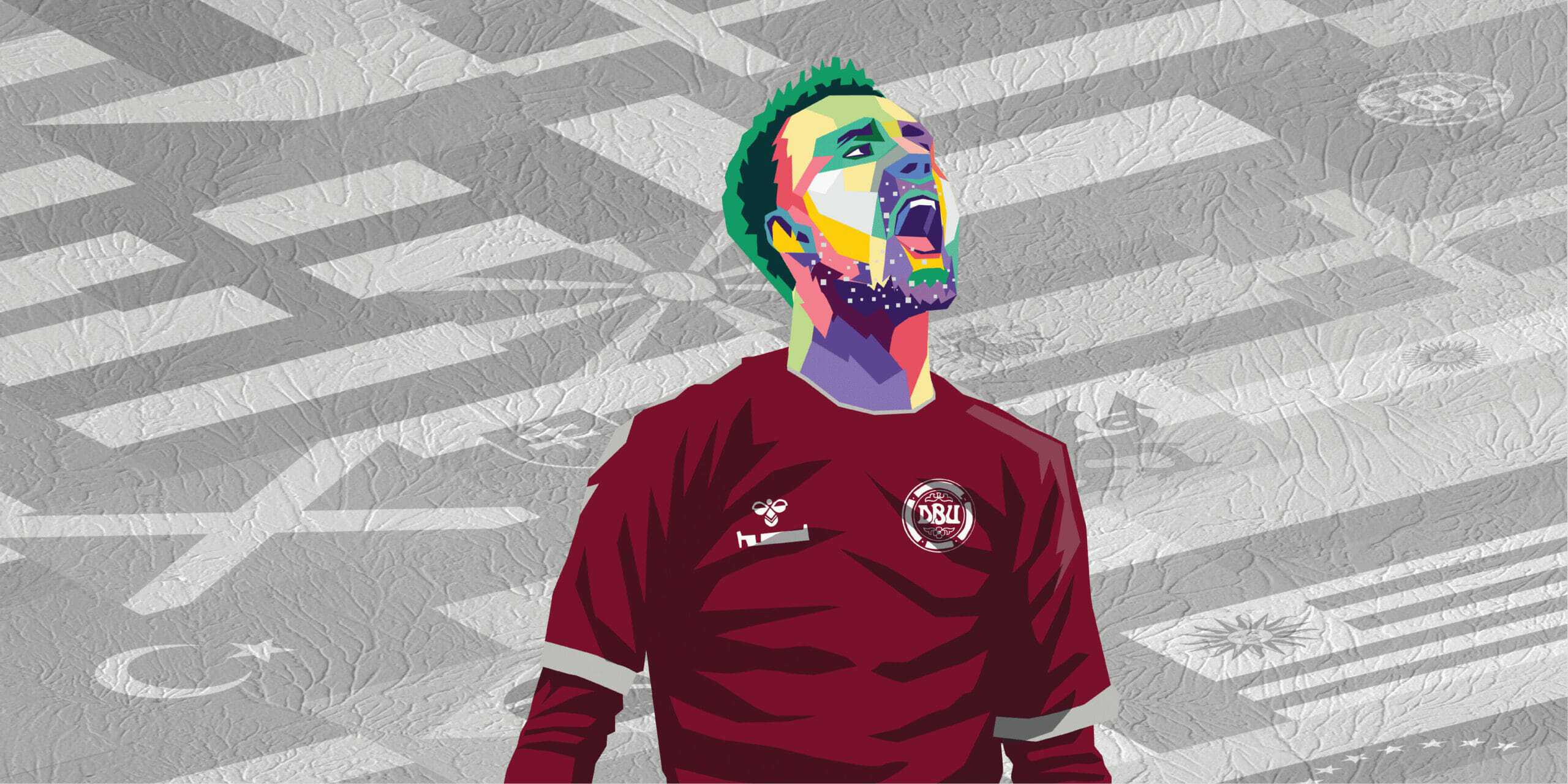




Comments